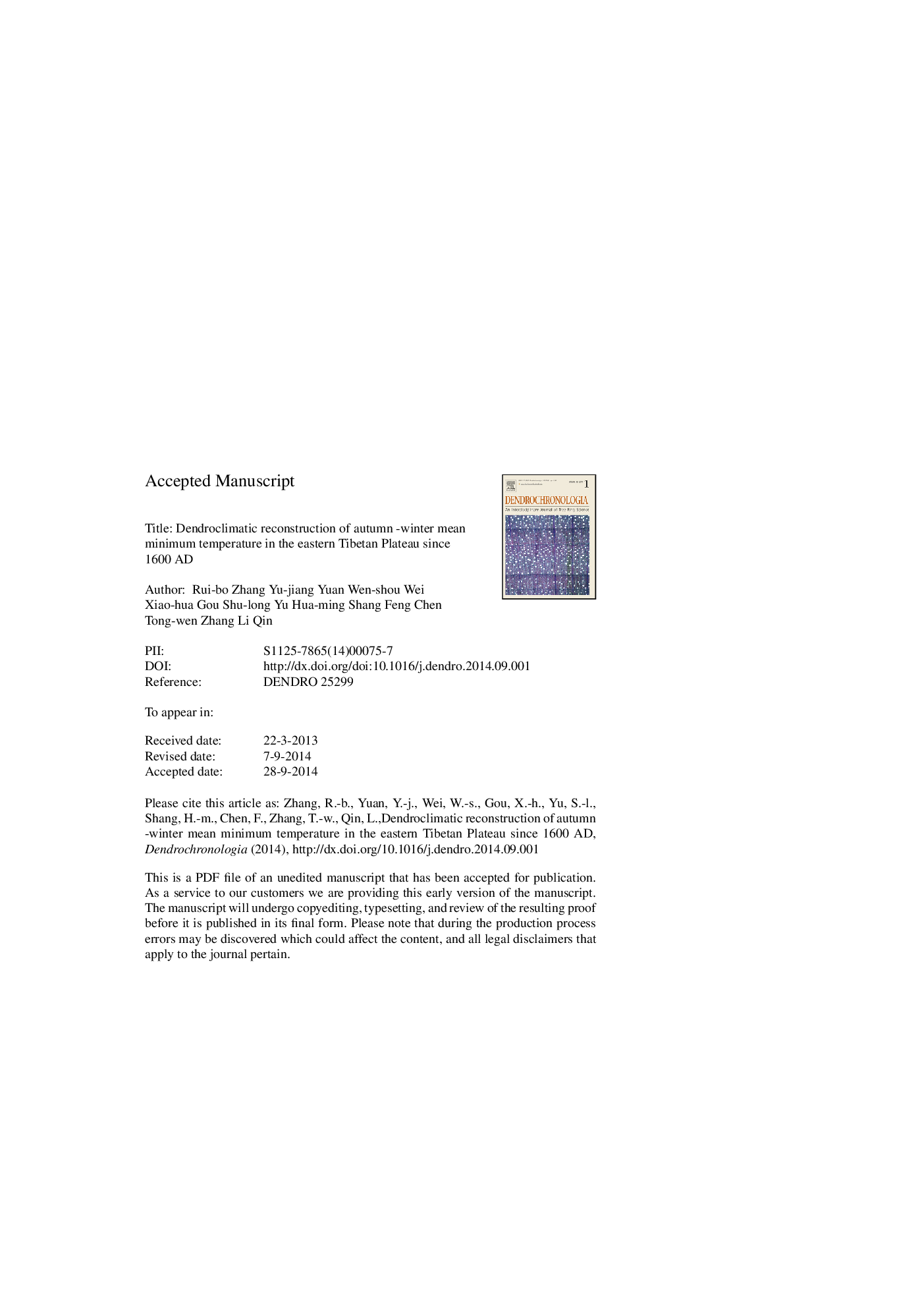| کد مقاله | کد نشریه | سال انتشار | مقاله انگلیسی | نسخه تمام متن |
|---|---|---|---|---|
| 6541372 | 159104 | 2015 | 29 صفحه PDF | دانلود رایگان |
عنوان انگلیسی مقاله ISI
Dendroclimatic reconstruction of autumn-winter mean minimum temperature in the eastern Tibetan Plateau since 1600 AD
ترجمه فارسی عنوان
بازسازی دندروکلیماتیک پاییز و زمستان حداقل درجه حرارت در فلات شرقی تبت از 1600 میلادی
دانلود مقاله + سفارش ترجمه
دانلود مقاله ISI انگلیسی
رایگان برای ایرانیان
کلمات کلیدی
تبت پلاتو، منطقه قمد، درخت حلقه، حداقل دمای حداقل،
موضوعات مرتبط
مهندسی و علوم پایه
علوم زمین و سیارات
علم هواشناسی
چکیده انگلیسی
We developed three tree-ring width chronologies of Dragon Spruce (Picea likiangensis var. balfouriana) from Qamdo region in the eastern Tibetan Plateau. It was found that the autumn-winter mean minimum temperature was the principal factor that limited the radial growth of Dragon Spruce. In particular, the tree-ring width chronology of the Changdu site was related significantly and positively with the autumn-winter mean minimum temperature. Using standard dendrochronological (STD) method, we obtained a 400-year reconstruction of October-January minimum temperature at the Qamdo meteorological station. The reconstruction explains 43.1% of the variance in the instrumental temperature records during the 1954-2006 calibration periods. It indicates that quasi-periodic changes exist on scales of 5, 11, and 102-103a. The temperature fluctuates around the mean and rises slowly from 1594 to the 1700s, following which the autumn-winter mean minimum temperature exhibited obvious stage changes with warmer periods (1769-1800, 1819-1849, 1873-1900, 1926-1954, 1987-2006) and colder periods (1716-1768, 1801-1818, 1850-1872, 1901-1925, 1955-1986). The temperature in the eastern Tibetan Plateau and the mean temperature in the Northern Hemisphere exhibited good consistency in the 20th century. From 1900 to the 1930s, the temperature rose slowly and then declined sharply in the 1940s. In the 1950s, the temperature rose, before falling again in the early 1960s, prior to a gradual increase following the late 1960s. The temperature in Qamdo represents the temperature of the southeastern Tibetan Plateau, and significant positive correlations were found with other temperature reconstructions on the southeastern Tibetan Plateau and the southern slopes of the Himalaya (including the Indian peninsula). The India-Burma Trough may have a certain effect on climate change in the eastern Tibetan Plateau. The reconstruction sheds new light on temperature variability and change in a region where the climate history for the past several centuries is poorly understood.
ناشر
Database: Elsevier - ScienceDirect (ساینس دایرکت)
Journal: Dendrochronologia - Volume 33, 2015, Pages 1-7
Journal: Dendrochronologia - Volume 33, 2015, Pages 1-7
نویسندگان
Rui-bo Zhang, Yu-jiang Yuan, Wen-shou Wei, Xiao-hua Gou, Shu-long Yu, Hua-ming Shang, Feng Chen, Tong-wen Zhang, Li Qin,
